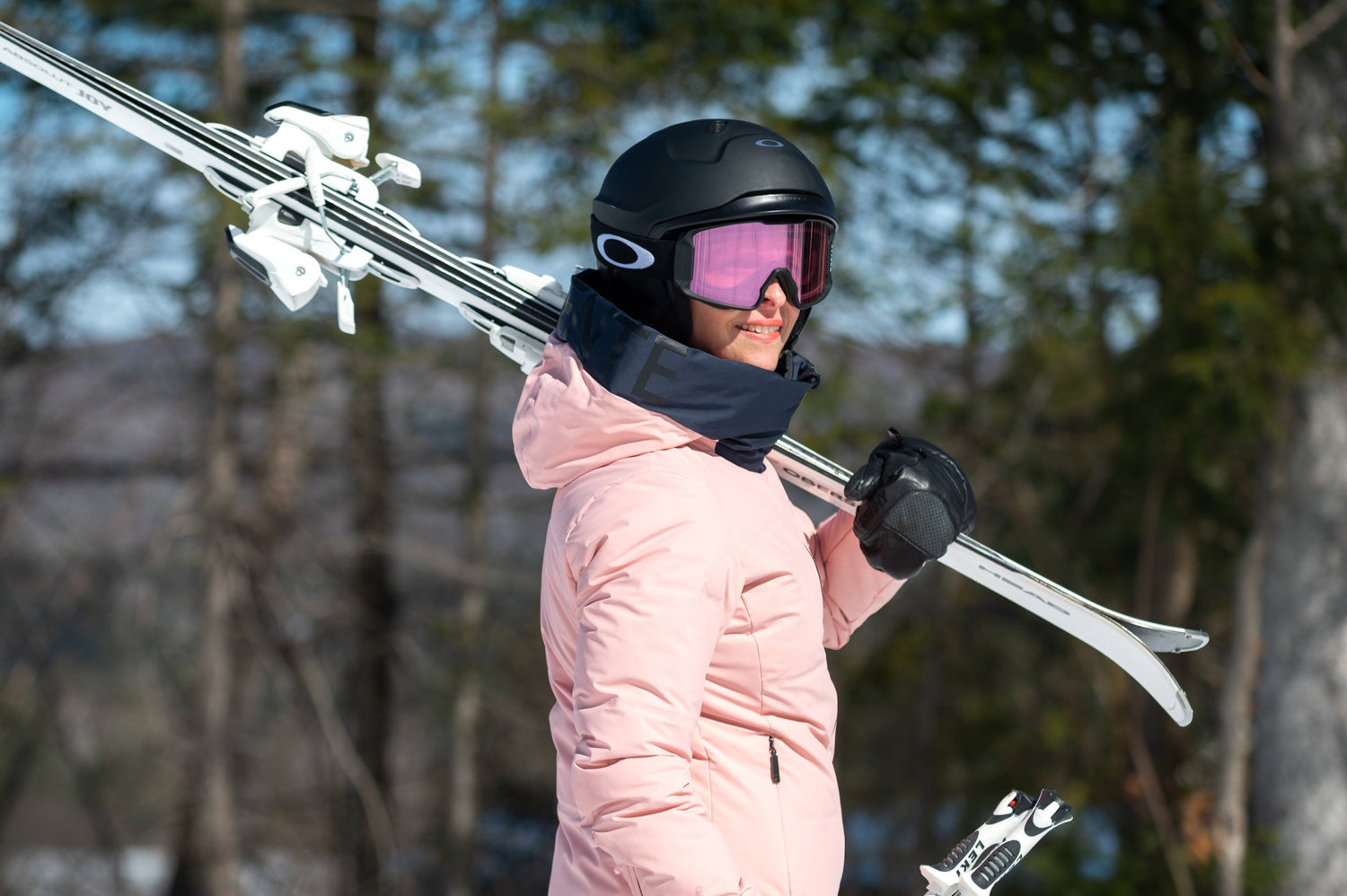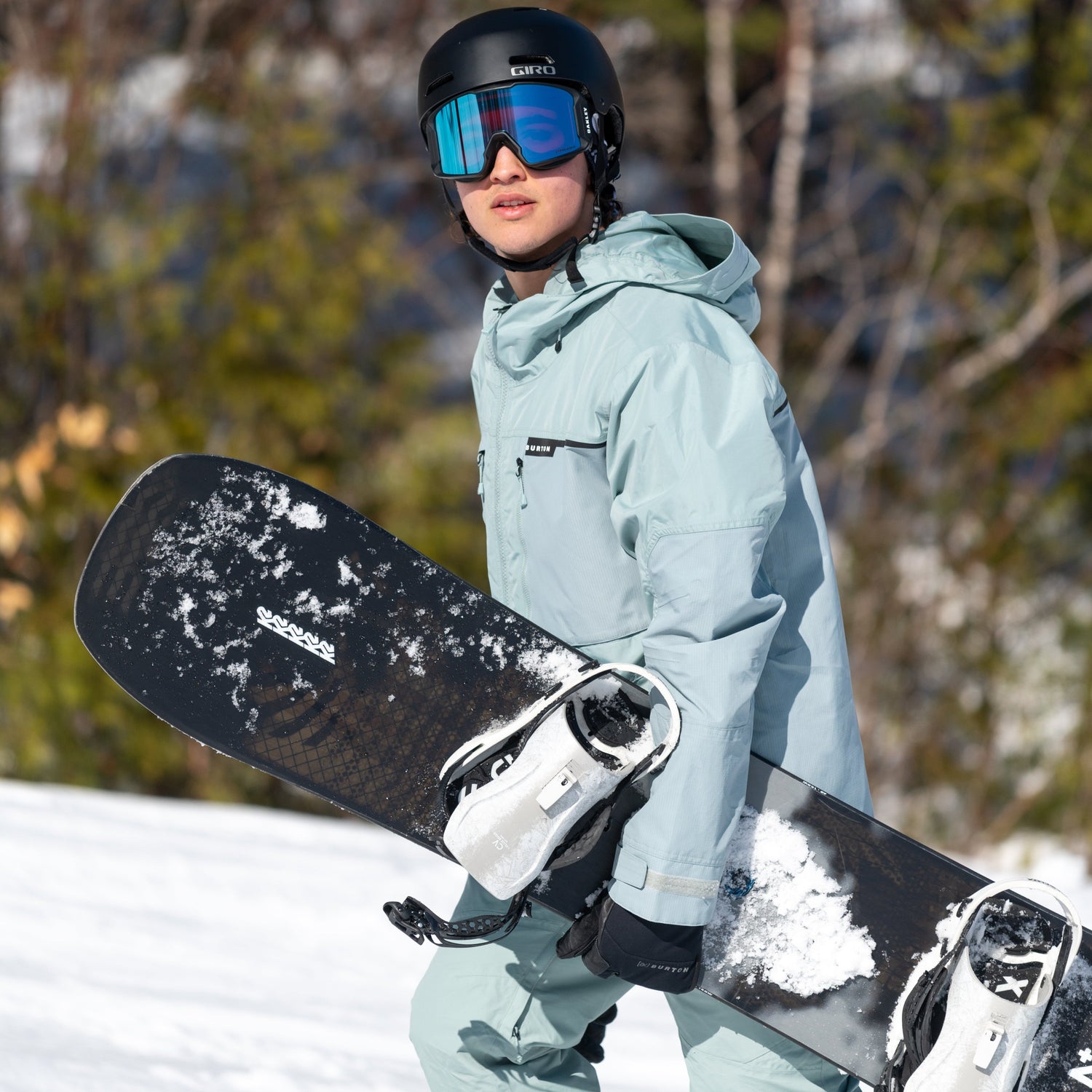Like the ancient Scandinavian peoples who pursued reindeer across the tundra on their wooden skis, modern backcountry skiers hunt for untracked powder. Today, these backcountry explorers have swapped wicker straps for a broad range of metal and plastic bindings. But which type to choose? Here’s an overview of the various types of alpine touring (aka AT or backcountry) bindings and the key points to consider to choose the one that best fits your skiing style and goals in the mountains.
Shop Alpine Touring Ski Bindings

Anatomy of an AT Binding
Like their downhill counterparts, touring bindings consist of a toe piece, a heel piece, and brakes (or a leash). Unlike alpine bindings, touring bindings let you ascend with a free heel. Uphill travel involves climbing skins under the skis and a technique similar to classic cross-country skiing. For steep terrain, they often include risers that make climbing easier. Then, the heel piece can be switched into descent mode to hold the heel in place and ski down the slopes with an alpine technique.

Frame Bindings
These AT bindings most resemble traditional alpine bindings. They feature an adjustable toe piece and heel piece on a hinged frame. The frame easily locks to switch from walk mode, where the heel is free, to downhill mode, attaching the heel and delivering a performance comparable to alpine ski bindings.
Who should choose a frame binding?
If you love huge jumps, dropping dizzying cliffs, and doing unbelievable tricks—in short, if you’re an extreme freestyle skier who just sends it—this type of binding could meet your needs. That said, some hybrid bindings (covered below) should also be considered, depending on your priorities.
This type of binding could also be the right choice if you mainly want to ski at resorts with the same performance and safety as an alpine binding and go on an occasional, not too demanding excursion into the backcountry.
Pros
- Fully DIN Certified (an international safety standard ensuring that the bindings release the boot during falls to minimize injuries).
- Their intuitive mechanism allows for a quick switch from climbing to skiing down.
- Downhill performance comparable to alpine bindings, with an elasticity and heft that provide stability, precision, and shock absorption perfect for aggressive skiing.
- Compatible with alpine ski boots.
- Often a less expensive option.
Cons
- The pivot point is located too far forward for a natural stride, which tires out the glutes and hip flexors.
- They’re heavier (at least 1,600 g per pair), which makes the uphills much less enjoyable.
- There’s a weight penalty with every stride because, unlike tech bindings, you lift the entire binding with every movement.

Tech Bindings
Tech bindings are the lightest option. They have a toe and heel piece that secure AT boots with metal pins. The toe piece inserts pins into the front of the boot, providing a natural pivot point for ascents. In downhill mode, pins lock down the heel.
Who should choose a tech binding?
These bindings are aimed at those who ski almost exclusively in the backcountry. They’re also a good choice if you have the budget for at least a two-ski quiver with one pair for the backcountry and another for resorts.
What type of tech binding should I buy?
Super Lightweight Race Bindings
Do you have serious skimo mojo? Do you have a weakness for spandex racing outfits? If so, you should think about a race binding. Often weighing less than 150 g each, these featherweights let you cut seconds or even minutes off the climb, but you’ll feel that lightness on the way down, where the lack of stability and vibration dampening makes for a less enjoyable experience. And with only one release value, they’re unsuitable for fast, aggressive skiers.
Ski Mountaineering Bindings
If your favourite YouTube series is The Fifty Project (and now The Fifty+), you dream of conquering high peaks, and your ski season is just getting started in April, you need a ski mountaineering tech binding. They are also a good choice for those who want to accumulate a lot of elevation with multiple laps on the skin trails at resorts. Weighing in at under 400 g and usually featuring several riser heights, they let you efficiently tackle tough climbs. At the same time, they have an adjustable release value and are a bit more substantial, so you can make smooth turns on long, euphoric descents (in good conditions).

All-Mountain Tech Bindings
These bindings weigh between 300 g and 700 g, have more features, and are somewhat burlier. With better power transfer, brakes, multiple riser levels, and more release values, the backcountry is your playground. They offer a better overall skiing experience in variable conditions.
Pros of Tech Bindings
- Their lightness makes uphills more enjoyable and efficient.
- Often compatible with ski crampons, which provide better traction on hardpack or ice when skins aren’t effective.
- The pivot point at the ball of the foot gives you a more natural stride on the way up.
Cons
- Lack of elasticity—not much shock absorption and vibration dampening.
- Limited compatibility since they require boots with tech inserts.
- Not DIN certified like alpine bindings, though many comply with other standards.

Hybrid Bindings
They combine a tech toe piece with an alpine heel for a natural pivot point on the ascent and downhill performance similar to alpine bindings. Some have a toe piece that can be converted into an alpine toe piece. Their weight is somewhere between frame and tech bindings, which will help you enjoy long days in the backcountry.
Who should go with a hybrid binding?
Hybrid bindings are a great choice for those who want to evenly split their time between resorts and backcountry touring with a one-ski quiver.
Pros
- Lighter than frame bindings.
- Some are DIN certified for safer downhill skiing.
- Elasticity and overall performance similar to downhill bindings.
- The pivot point at the ball of the foot gives you a more natural stride on the way up.
- Often compatible with ski crampons, which provide better traction on hardpack or ice when skins aren’t effective.
Cons
- Heavier than tech bindings.
- Limited compatibility since they require boots with tech inserts.
- Not available with high DIN values.
How to match bindings and skis?
Generally, heavy and wide skis should be paired with heftier bindings and vice versa. That said, if you have the budget for a quiver that includes a ski exclusively for deep powder, lightweight bindings can work well on wide skis. They make uphills easier without sacrificing much downhill performance in the right conditions.
Installation and Setting Release Values
For your safety, we strongly recommend having one of our expert technicians install your bindings and set the release value.




